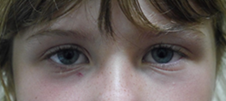Hot Topic Blog - Oral/Pharyngeal Sensory-Motor, Orofacial Myofunctional, & Airway Information
THERE IS SOMETHING IN THE AIRBy Rochelle McPherson, Orofacial Myofunctional Therapist in AustraliaJuly 2016 |
|||
|
We know the importance of nasal breathing yet many of our patients still mouth breathe, even after the removal of adenoids and tonsils (adenotonsillectomy). It’s not always as simple as saying “close your lips and breathe through your nose.” Sometimes people will undergo breathing retraining and still find it difficult to nose breathe.
The first thing I look at when someone enters my room is their eyes. The eyes can tell us so much. I look for dark circles under the eyes (known as allergic shiners or Venus Pooling) and folds under the eyes (Dennie-Morgan lines). Children do not normally have wrinkles under the eyes so when I see this, I start thinking allergies.
Allergies ca
Allergies are the most common cause of a congested nose in children, leading to inflammation in the ears due to fluid accumulation, which can decrease hearing. Allergies can also cause earaches, itching, popping, and fullness. One in five people suffer from allergic rhinitis.
I also take notice if people are rubbing their noses or eyes. Do they have any skin rashes or eczema? Most people with eczema have a personal or family history of allergies. Have they ever suffered from asthma? Asthma and allergies often go hand-in-hand. Approximately 90% of children with asthma have allergies compared to 50% of adults with asthma. Does the person sneeze or cough? Do they have a runny, stuffy nose or itchy eyes? Do they experience stomach upsets?
Nasal congestion leads to mouth breathing, and we know that mouth breathing can affect craniofacial growth causing problems with oral development. It is interesting how many parents do not associate hay fever with allergies. We really need to be educating our patients about allergies and asking if there is any family history.
Understanding allergies has changed the way I practice, and I now regularly follow my patient’s orofacial myofunctional assessment with a referral to an allergy clinic. In Australia, we test for 37 different airborne, 33 food, and 10 nut allergens. A skin prick test is the gold standard of testing; however, a blood test can also be used.
At an appointment with an allergist, the doctor carries out a skin prick allergy test, an anterior nasal endoscopy looking at the mucosa and turbinates, an oral examination, and a rhinomanometry test (on children over ten years of age) to assess any nasal airway resistance. If they have allergies or inflammation, patients are put on a six-week course of nasal spray. Many people are not aware it takes six weeks for the nasal spray to have a full affect.
Following the six-week use of nasal spray, the patient will return to the doctor for a repeat rhinomanometry test and an anterior nasal endoscopy. If there is no improvement or the allergy test was not positive, the patient is referred to the ENT (otolaryngologist) to rule out adenoid enlargement or other structural reasons for the airway obstruction. Then a case conferencing appointment is made putting the multidisciplinary care into action. Attending this appointment is the ENT, the doctor who performed the allergy test, myself (the orofacial myofunctional therapist), and the dentist/orthodontist.
Once an allergy has been determined, treatment can begin. A lot of parents do not know that allergies can even be treated. So many people I see have been told they have allergies but have never even had an allergy test. Once people know what they are allergic to, they can reduce their exposure to that allergen and undergo immunotherapy treatment or Rhinolight therapy.
Many of my patients who have allergies have been told to use a nasal spray when they feel congested or need it. The problem with this is congestion is the norm for them and they do not realise how congested they are. And, they often don’t feel they even have a problem breathing as they can mouth breathe.
Education is so important. Early identification and treatment of childhood allergies dramatically improves a child’s quality of life, which is a goal we can all share.
About the Author
With over 25 years of experience in dental hygiene and related fields, Rochelle is one of Australia’s leading practitioners of Orofacial Myology. Rochelle’s expertise is highly sought after in the industry, and she regularly conducts training and mentoring for other practitioners in the field. Rochelle is the current president of the Australian Association of Orofacial Myology.
Rochelle is passionate about providing her clients with the best possible health tools to assist them in their journeys to total wellness. She offers a unique approach to Orofacial Myofunctional Therapy, adopting a holistic, well-rounded approach to helping patients reach their treatment goals. By bringing a unique range of skills and techniques to Orofacial Myology, Rochelle is committed to advancing the discipline in Australia through best practice and continuing education.
You may learn more about Rochelle’s work on her website: http://www.omhealth.com.au/. And, here is Rochelle’s email address if you wish to contact her: Rochelle rochelle@omhealth.com.au |
|||
 n cause congestion in the nose which in turn can cause poor circulation of blood in the eye region. This results in low oxygen levels in the surrounding tissue.
n cause congestion in the nose which in turn can cause poor circulation of blood in the eye region. This results in low oxygen levels in the surrounding tissue.